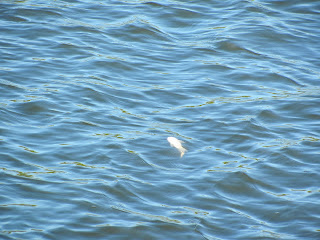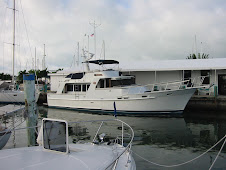
Departing Everglades City, we headed to Little Shark River. We passed Indian Key, where John James Audubon once camped while drawing and studying the region’s native birds. It is a favorite roosting spot for beautiful white pelicans.

Little Shark River’s entrance channel is the shallowest of the region. We were at high tide inbound, and so had no difficulty. We proceeded about ½ mile upriver, to anchor mid-channel in deep water.

This is one of the most beautiful anchorages in the area. The dark waters and strong tidal currents reflect a shoreline heavily wooded with cypress, pine and hardwoods. Hundreds of years before the Europeans arrived here, Timucuan Indians poled their canoes along these shores. Now, fishing boats find good catching along the river’s banks.

The snowy egrets roost in the mangroves along the shore, and then take sudden flight in a flurry of beating wings.

The next morning, after making our way out of Little Shark River in much skinnier water, we crossed Florida Bay. Our destination is Marathon, about halfway down the chain of the Florida Keys. This was our first visit to our new southern club home, Marathon Yacht Club. We docked with kind assistance from fellow members, and had an excellent dinner in the clubhouse that evening. Later, we met many members at the Club’s hot dog roast, held every Sunday night.

Known as the “Heart of the Keys,” this area has long been inhabited by Native Americans, seafarers, and other settlers. Then, in the early 1900s, the Florida East Coast Railway came through, and the island became known as Marathon, allegedly from the railroad workers who likened the pace of construction to a Marathon race.

The island has about 10,000 year-round residents, and about 280 mooring balls in its Boot Key Harbor, which if full to capacity. As we settled onto a mooring ball for a month’s stay, we are learning that the locals are among the friendliest and most down-to-earth folks. We have attended a potluck supper of boaters at the City Marina headquarters, and Sunday service at the United Methodist Church. It really is a cruiser’s paradise, with West Marine, Daffy Doug’s Dollar Store and Publix Supermarket all within walking distance.
 Departing Everglades City, we headed to Little Shark River. We passed Indian Key, where John James Audubon once camped while drawing and studying the region’s native birds. It is a favorite roosting spot for beautiful white pelicans.
Departing Everglades City, we headed to Little Shark River. We passed Indian Key, where John James Audubon once camped while drawing and studying the region’s native birds. It is a favorite roosting spot for beautiful white pelicans. Little Shark River’s entrance channel is the shallowest of the region. We were at high tide inbound, and so had no difficulty. We proceeded about ½ mile upriver, to anchor mid-channel in deep water.
Little Shark River’s entrance channel is the shallowest of the region. We were at high tide inbound, and so had no difficulty. We proceeded about ½ mile upriver, to anchor mid-channel in deep water. This is one of the most beautiful anchorages in the area. The dark waters and strong tidal currents reflect a shoreline heavily wooded with cypress, pine and hardwoods. Hundreds of years before the Europeans arrived here, Timucuan Indians poled their canoes along these shores. Now, fishing boats find good catching along the river’s banks.
This is one of the most beautiful anchorages in the area. The dark waters and strong tidal currents reflect a shoreline heavily wooded with cypress, pine and hardwoods. Hundreds of years before the Europeans arrived here, Timucuan Indians poled their canoes along these shores. Now, fishing boats find good catching along the river’s banks. The snowy egrets roost in the mangroves along the shore, and then take sudden flight in a flurry of beating wings.
The snowy egrets roost in the mangroves along the shore, and then take sudden flight in a flurry of beating wings. The next morning, after making our way out of Little Shark River in much skinnier water, we crossed Florida Bay. Our destination is Marathon, about halfway down the chain of the Florida Keys. This was our first visit to our new southern club home, Marathon Yacht Club. We docked with kind assistance from fellow members, and had an excellent dinner in the clubhouse that evening. Later, we met many members at the Club’s hot dog roast, held every Sunday night.
The next morning, after making our way out of Little Shark River in much skinnier water, we crossed Florida Bay. Our destination is Marathon, about halfway down the chain of the Florida Keys. This was our first visit to our new southern club home, Marathon Yacht Club. We docked with kind assistance from fellow members, and had an excellent dinner in the clubhouse that evening. Later, we met many members at the Club’s hot dog roast, held every Sunday night. Known as the “Heart of the Keys,” this area has long been inhabited by Native Americans, seafarers, and other settlers. Then, in the early 1900s, the Florida East Coast Railway came through, and the island became known as Marathon, allegedly from the railroad workers who likened the pace of construction to a Marathon race.
Known as the “Heart of the Keys,” this area has long been inhabited by Native Americans, seafarers, and other settlers. Then, in the early 1900s, the Florida East Coast Railway came through, and the island became known as Marathon, allegedly from the railroad workers who likened the pace of construction to a Marathon race. The island has about 10,000 year-round residents, and about 280 mooring balls in its Boot Key Harbor, which if full to capacity. As we settled onto a mooring ball for a month’s stay, we are learning that the locals are among the friendliest and most down-to-earth folks. We have attended a potluck supper of boaters at the City Marina headquarters, and Sunday service at the United Methodist Church. It really is a cruiser’s paradise, with West Marine, Daffy Doug’s Dollar Store and Publix Supermarket all within walking distance.
The island has about 10,000 year-round residents, and about 280 mooring balls in its Boot Key Harbor, which if full to capacity. As we settled onto a mooring ball for a month’s stay, we are learning that the locals are among the friendliest and most down-to-earth folks. We have attended a potluck supper of boaters at the City Marina headquarters, and Sunday service at the United Methodist Church. It really is a cruiser’s paradise, with West Marine, Daffy Doug’s Dollar Store and Publix Supermarket all within walking distance. 










